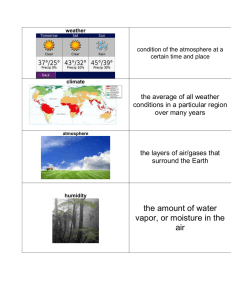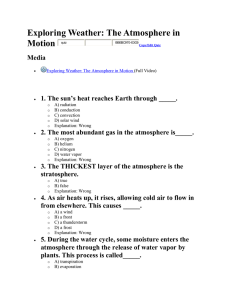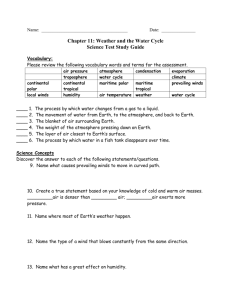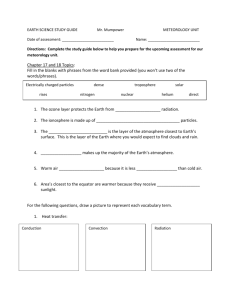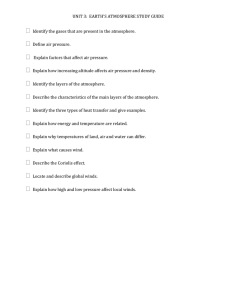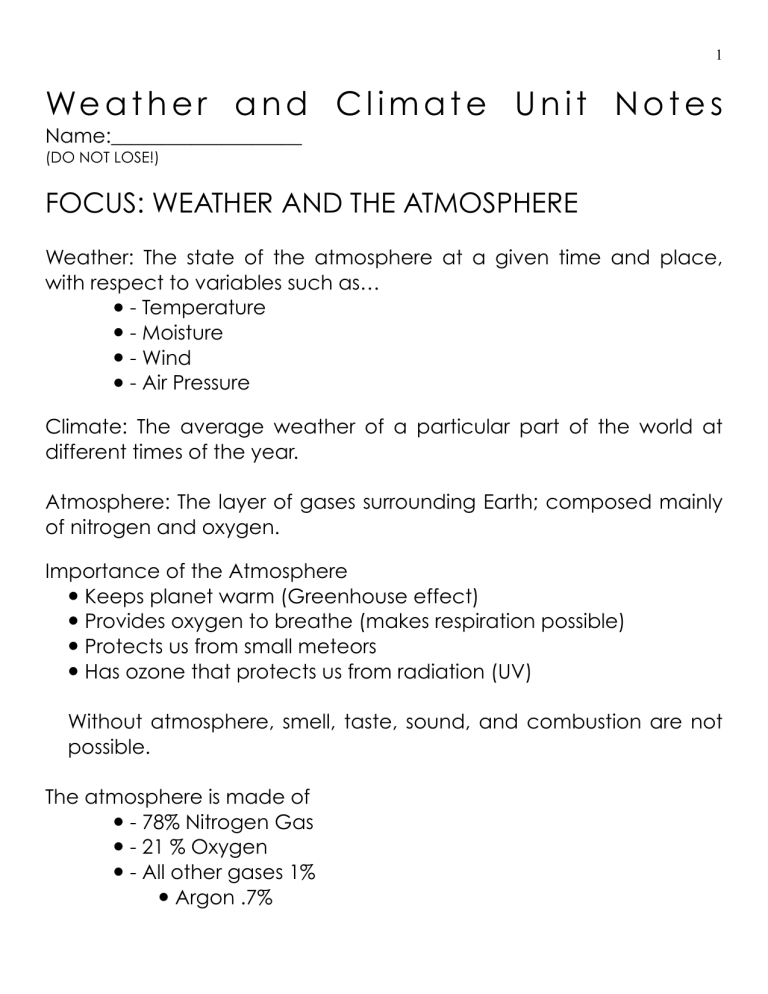
!1 We a t h e r a n d C l i m a t e U n i t N o t e s Name:___________________ (DO NOT LOSE!) ! FOCUS: WEATHER AND THE ATMOSPHERE ! Weather: The state of the atmosphere at a given time and place, with respect to variables such as… ● - Temperature ● - Moisture ● - Wind ● - Air Pressure ! Climate: The average weather of a particular part of the world at different times of the year. ! Atmosphere: The layer of gases surrounding Earth; composed mainly of nitrogen and oxygen. ! Importance of the Atmosphere ● Keeps planet warm (Greenhouse effect) ● Provides oxygen to breathe (makes respiration possible) ● Protects us from small meteors ● Has ozone that protects us from radiation (UV) ! Without atmosphere, smell, taste, sound, and combustion are not possible. ! The atmosphere is made of ● - 78% Nitrogen Gas ● - 21 % Oxygen ● - All other gases 1% ● Argon .7% !2 ! ● Carbon Dioxide .2% ● Neon ● Helium ● Methane ● Krypton ● Hydrogen ● Xenon ● Title: Layers Of Atmosphere ● Spread these 5 bullets out over a page. Draw relevant things after titling layer.● - Troposphere – Weather occurs here, life, air travel. ● - Stratosphere - Ozone found here. ● - Mesosphere – Meteors burn up here ● - Thermosphere – Space shuttle orbits here, Aurora borealis ● - Exosphere – Merges with space, some satellites here. !3 ! ! ! ! ! ! ! New Area of Focus: Air Quality and Pollution ! Air Pollution can be • Global (Global Warming) !4 ! ! ! • Regional (Acid Rain) • Local (Smog) To avoid carbon monoxide poisoning, Do not… ● Run a car in a closed garage ● Burn charcoal indoors or in a tent ● Run a generator indoors ● Burn anything without ventilation Ozone Layer ● - Layers of atmosphere ● - Gas made of 3 oxygen atoms (O3) ● - Absorbs 99% of suns harmful UVB rays ● - Chloroflurocarbons, (CFC’s) made by humans in aerosols destroy Ozone ● - Humans have created a hole in the ozone layer. Ways to avoid skin cancer ● Don’t sunbathe. The sun is radiation ● Tanning also increases your risk ● Avoid the sun, especially between 10-4PM ● Seek shade ● Wear a shirt (thicker and darker) ● Wear sunglasses ● Be especially wary fair skinned people ! ! ! ! ! New Area of Focus: Air Pressure, The factor that controls the weather. ! !5 Air Pressure: The pressure caused by the weight of the atmosphere. ! ! ! ! ! As elevation increases, air pressure decreases. ! As you increase in elevation, pressure decreases. Inverse relationship !6 ! Barometer – Instrument that measures air pressure. ! ! Air Pressure drives the wind and creates the weather. ! Warm air rises, cool air sinks. Warm is low pressure, Cold is High Pressure. ! ● Most importantly, wind travels from areas of high pressure to areas of low pressure! !7 ! ! ! ! Pictures for heat transfer ! Convection: Vertical circulation in which warm rises and cool sinks. --Flow of heat by this circulation. Conduction: The movement of heat from one molecule to another. Radiation: Energy that is radiated or transmitted in the form of rays or waves or particles. ! Warm Fronts and Cold Fronts, caused by air pressure. ! Cold Front: Form where cold air moves towards warm air. Creates rain storms. !8 ! ! ! Warm Front: Form where warm air moves towards cold air. ! ! !9 ! ! Occluded front: When a cold overtakes a warm and forces it up (Mix) ! ! Stationary Front: When cold and warm cannot overtake each other (tie) !10 ! Wind ● - The movement of air, from high pressure to low pressure. ● - The wind is caused by the different temperatures (and therefore air pressure differences) around a planet - this is caused by the Sun. ● - Temperature differences over the land and over seas. ● - The topography of the land (Mountain Effect) ! ! ! ! Global Winds ● - Doldrums ● - Horse latitudes ● - Trade Winds ● - Prevailing Westerlies ● - Polar Easterlies !11 ! ! ! ! ! The rotation of the Earth (which causes the Coriolis force). - Coriolis Force – Rotating body deflects. The Jet Stream: Any of the high-speed, high-altitude air currents that circle the Earth in a westerly direction. ! Sea Breeze (Day)- The breeze that blows from the sea toward the land during the day, !12 ! Caused by air rising over the warmer land (day) and is replaced by cooler air from above the sea. ! ! Land Breeze (Night): The breeze that blows from the land toward the sea. ! !13 ! ! ! ! Mountain Winds: Mountains can create strong winds. Warm air rises up Mtn. (day), Cool air sink down Mtn. (Night) ! ! Mountain Rain Shadow Effect: ! ! Wind Chill - The cooling effect of wind and temperature combined. The higher the wind, the cooler it gets. ! Flight. !14 - Simple combination of Bernoulli’s Principle and Newtons 1st law of motion. - Air flows faster over the top of the wing than the bottom making less pressure, higher pressure underneath pushes the wing up. ! Dangerous Weather Systems ! ! Storms: Rapid changes in air pressure cause a disturbance. ■ Hurricanes ■ Tornados ■ Blizzard ■ Microburst ■ Thunderstorm ■ Ice Storm New Area of Focus: Light and Temperature ! Light: An energy wave. Black absorbs all colors of the spectrum while white reflects. ! Albedo: The reflectiveness of a surface. !15 ! ! Dark colored materials heat up quicker than light colored materials. Air above dark colored surfaces heats up quicker. ! ! Temperature: A measure of the average kinetic energy (motion) of individual molecules in matter. ● 100 degrees Celsius = Water Boils ● 0 degrees Celsius = Water Freezes Thermometer: A measure of the heat from expanding and contracting liquids or coils. ! WHAT CAUSES THE SEAONS? ● The tilt of the earth’s axis 23.5 degrees ● Summer = Northern Hemisphere is tilted into more direct light. ● Winter = Northern Hemisphere tilts away from the direct light. ! ! !16 ! ! Different parts of the world have seasons at different months of the year. ! ! ! Part III: Earth the water planet ! ● High Specific Heat: Hydrogen bonds absorb heat when they break, and release heat when they form. ! The Oceans -Heat and cool the earth. -The oceans influence climate by absorbing solar radiation and slowly releasing heat needed to drive the atmospheric circulation. (High Specific Heat). -Warm seas and wind are moved to the icy poles -Humidify and dry the planet. -Control the wind speed and direction. -Part of the water and carbon cycle -Phytoplankton in ocean produces half the oxygen -Releases aerosols (small particles) that influence cloud cover, fall as rain, and absorbing carbon. ! !17 ! • El Nino: A warming of the surface water of the eastern and central Pacific Ocean, occurring every 4 to 12 years and causing unusual global weather patterns. – Generally occurs in winter. – Winds get weaker, thus ocean gets warmer. – Thunderstorms that normally occur on the equator move eastward. • Southwest U.S. gets more water, Australia and Indonesia gets less (maybe). • La Nina: Unusually cold temperatures in Pacific. Brings the opposite of El Nino. The hydrologic cycle: The continuous movement of water on, above, and below the surface of the Earth. ! ! Evaporation – Substance changes from a liquid state to gas state (requires energy). ! Condensation – Water vapor (gas) turns back to a liquid. (energy required / cold) -cloud formation. ! Precipitation – Water that is so heavy it falls as liquid / solid. !18 ! Sublimation – Solid state turns directly to a gas state skipping liquid phase. ! Evapotranspiration – Water released by plants into air. ● Non-living to the living, and back again. ! Surface run-off: The water flow which occurs when soil is full to capacity and excess water travels over the land. ! Percolation: The slow movement of water through the soil. ! Groundwater discharge: Water that has been underground seeps back into the oceans, or into rivers or lakes. ! ! Humidity: Wetness in the atmosphere Evaporation: Water turns from liquid to gas. Condensation: Water turns from gas to liquid ! Dew: moisture condensed from the atmosphere, esp. at night, and deposited in the form of small drops upon any cool surface. ! Dew Point: The temperature to which air must be cooled for saturation to occur. ! Sling psychrometer: Device used to measure humidity. ! Cloud: A visible body of very fine water droplets or ice particles suspended in the atmosphere at different altitudes. ! ! Clouds ● Water molecules attach to a condensation nuclei. !19 Fog: A cloud bank that is in contact with the ground. In really dry places, morning fog can be collected. Desert animals take advantage of dew. ! ● The three main types are ● - Cirrus (Wispy) ● - Cumulus (Puffy) ● - Stratus (Layered) ! ! ● Cumulonimbus ● Very tall ● Dense, heavy, dark massive thunderstorms ● hard showers, explosive top, great vertical development ! ! ! ! ! !20 Meteorology: The study of atmosphere that focuses on weather process and forecasting. ! ● Most common weather tools ● - Thermometer ● - Wind Vane – Wind direction ● - Anemometer – Wind speed ● - Barometer – Measures air pressure ● - Rain Gauge: Measures rainfall. ● - Snow / rain equivalent = One inch of rain is about 10 inches of snow and vice versa. ● - Satellites: Provide larger view of weather. ! Isotherm- A line drawn on a weather map or chart linking all points of equal or constant temperature. ! ! Ocean currents from tropics keep Arctic from growing too large. ! Ocean currents from poles keep tropics from becoming to warm. !21 ! ! ! NEW AREA OF FOCUS: ENHANCED GLOBAL WARMING / Climate Change ! Specifically: Enhanced global warming or Anthropogenic Global Warming. ! ! ! ● Global Climate Change: The gradual warming of the Earth caused by the greenhouse effect. ● The result of man-made emissions of greenhouse gases such as carbon dioxide. ● Greenhouse Effect: Trapping of Earth’s heat at or near the surface !22 ! The natural carbon dioxide oxygen balance on our planet. ! ! These fossils fuels when burned release carbon dioxide that has been locked away under the Earth for millions of years into the system. ! Increases in carbon dioxide levels in the atmosphere traps in more of the Earth’s radiant heat causing planet to warm. ! ! ● The Effects of global warming – The big 6 ● - Spread of Disease ● - More Hurricanes (warmer water) ● - Long droughts and intense heat waves ● - Rapid Ecological Changes ● - Economic consequences ● - Polar Ice Caps Melt and Sea Level Rise ● - Arctic species will lose habitat / become extinct. ! !23 Cartoon of these three Richard Alley Wallace Broecker ! John Christy ! ! ! ! NEW AREA OF FOCUS: BIOMES ! A biome is a large, distinctive complex of plant communities created and maintained by climate. ! Rainfall and temperature determine the type of biome. ! ! !24 ! ! Marine Biome: Covers ¾ of globe, oceans, coral reefs, estuaries. ! SAVE THIS FOR THE UNIT ASSESSMENT Copyright © 2010 Ryan P. Murphy ! ! ! ! ! ! ! ! ! ! !

